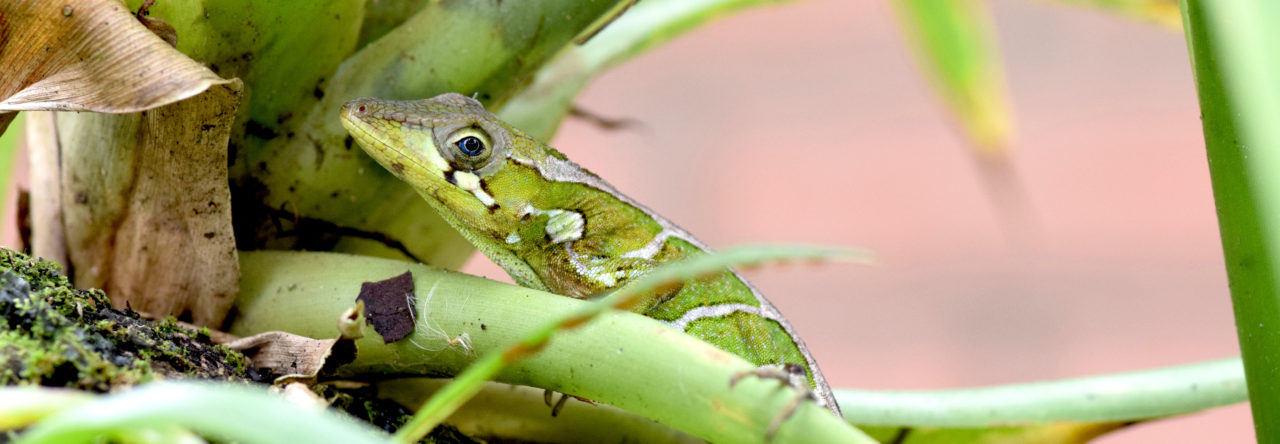Well, the 2012 Abaco Expedition is over. For almost a year, we’ve been wondering what effect Hurricane Irene had on our lizard populations. Now we know.
A little background: initially, we feared the worst. Hurricanes had destroyed several previous experiments. The culprit was not the high winds, but the high water, which put our tiny, lowlying islands underwater for up to six hours, drowning or sweeping away all lizardkind. But then word trickled in that this time, maybe things weren’t so bad. The storm had come at the best time possible–absolute low tide–and from a direction that minimized the amount of storm surge that could build up in the protected areas where most of our islands occurred. Maybe things weren’t so bad.
So, back we came to Abaco several weeks ago to find out. We have two experiments going on. The primary study focuses on the effect of anole-eating curly-tailed lizards. What effects do the curlies have on the population size and behavior of the brown anole, A. sagrei? And, in turn, how do these changes trickle down to lower levels of the food web? These studies occur on islands up to 300 square meters in area (that’s less than 1/2 the area enclosed by the bases in a baseball infield).
The result of the hurricane: mixed. Several islands lie in a very exposed position, and their populations were decimated, to less than 10 individuals on both. In case there’s any doubt about the culprit for this crash, the dried seaweed strung high in the bushes is clear evidence of the highwater mark of the storm. On most other islands, those not so exposed to the storm’s onslaught, A. sagrei populations are higher, even those with the curly-tailed lizards. It seems that it was a overall a good year for lizards, except for those islands exposed to the hurricane’s wrath.
Our founder effect experiment occurred on seven tiny–and very low-lying–islands. These islands were wiped lizard-free by the last hurricanes to pass through the region, Frances and Jeanne in 2004. We re-inoculated the islands with brown anoles in 2005, placing one male and one female on each island. As I reported previously, the genetic and phenotypic mark of these founder events were still evident four years later.
Given past history and the diminutive size of the islands, we were not optimistic. But here, too, the results were mixed. Three islands were almost exterminated: down to two adults (and, encouragingly, one recent hatchling) on one island, and 4-5 on two others. But as with the bigger islands, the results here, too, were mixed, as one population increased from 25 to 49 and several others held steady with large populations.
These results lead to an interesting situation. All populations were established by a founding event, but now only several of them have experienced a subsequent population bottleneck. How will that effect patterns of divergence among the island populations? And let’s not forget that those who have postulated the importance of founder effects for species divergence and even speciation suggested that it was serial founder events/bottlenecks that were particularly likely to lead to important changes. Who knows? Maybe next year we’ll return to find a couple of newly evolved species.
- Evolution in Real Time on Lizard Island - March 23, 2025
- Spider Snags Adult Anolis osa - March 22, 2025
- An Homage to the Green Anoles of New Orleans - March 21, 2025




Rich Glor
Thanks for the update. Its hard to imagine how these little guys are able to persist through a hurricane even when the island isn’t submerged. Do you think they’re just clinging to perches during the hurrican, or do they have another strategy? Seems like a testable hypothesis if somebody has access to a wind tunnel. This might be a nice follow-up to your eggs in saltwater story from a few years back…
Jonathan Losos
My guess is that they just hang tight, but it would be interesting to investigate further. One other part of the story: unlike some previous hurricanes, this one hit at mid-day. Hence, the lizards should have been awake and may have seen the rising water, and thus crawled up to avoid it, which perhaps they didn’t do during nighttime storms. Just a thought. Clearly, we need to have some cameras out there for the next one.